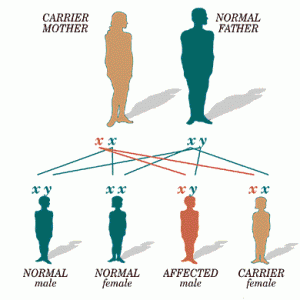Gender and Genes – How They Interact
For most inherited traits, the gender of the bearer of the genes is unimportant. However, there are exceptions that fall into three categories: sex-linked traits, sex-influenced traits, and sex-limited traits. Each one of them have different characteristics that make them unique:
A sex-linked trait is a gene found only on the X chromosome and not the Y chromosome. With these traits, sex linkage is linked to the gender of the individual because the gene controlling the trait is located on the sex chromosome. Therefore, the Y chromosome is missing this section of the X chromosome. This is why males exhibit some traits more frequently than females do. These traits can be significant in any species with non-homologous sex chromosomes. Scientists first saw this occurrence with the white eye gene in the fruit fly. The normal eye color of a fruit fly is a dull red, but mutations in the genes caused the eyes to be white (the white allele is recessive). They soon discovered that the inheritance pattern for this gene was different than the rest. It turned out that the particular white eye color gene was located on one of the two female X chromosomes. Males only possess one X chromosome, while females possess two, which is why X-linked recessive traits appear more commonly in males than in females; they have no second X chromosome to carry a dominant allele that could possibly hide the recessive one. Examples of sex-linked traits are: Red-green colorblindness, Hemophilia, and Duchenne Muscular Dystrophy.
Sex-limited traits are generally autosomal, meaning that they are not found on the X or Y chromosomes. These traits are expressed in only one gender, which utilizes primary and secondary sexual characteristics. There are genes that are carried by both males and females that only get used by one of the genders. For example, the gene that influences a lactating mother’s milk production is also carried by males. It’s never expressed by them because only females can exhibit that condition. Although males and females each carry two alleles, only females show the normal condition for milk production, therefore making it possible.
Sex-influenced traits are also autosomal, meaning that their genes are not carried on the sex chromosomes. An example of a sex-influenced trait is pattern baldness. Most people know it as male pattern baldness, but it is not exclusive to only males. The gene for pattern baldness has two alleles: “bald†and “non-bald.†The hormones in the individual are what influence the behavior of the alleles.  In the midst of high levels of testosterone, the baldness allele is very influential. In the midst of low levels of testosterone, this allele doesn’t have much of an effect. This is why males are much more prone to pattern baldness. Males have much higher levels of testosterone than females do, making the baldness allele behave like a dominant allele. Another example of a sex-influenced trait is in a person’s singing voice. The genetic influences that determine the key of a person’s singing voice (high or low) are autosomal, but both genders have opposite effects of the alleles.
